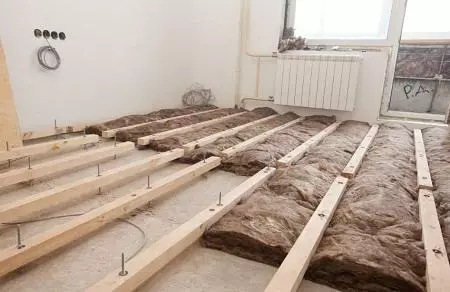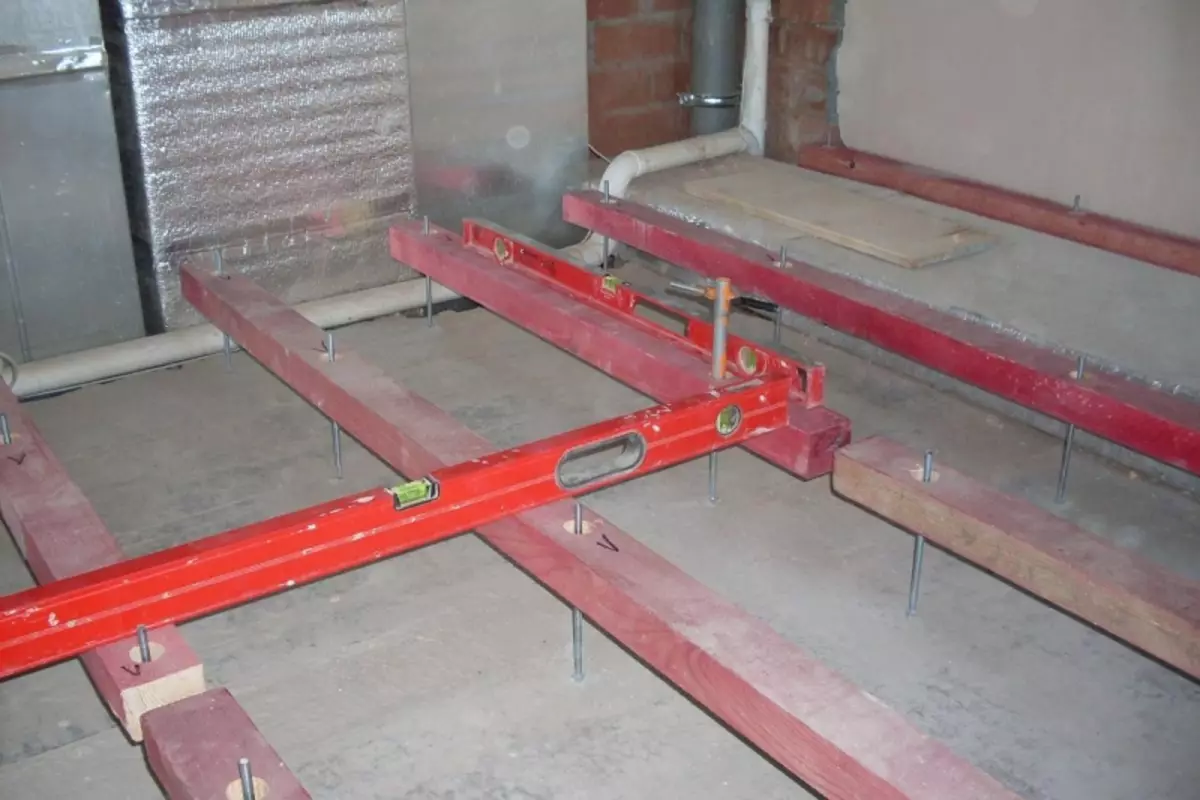
Thanks to the adjustable lags, you can make the perfectly smooth floor adjustable lags make it possible to do without such time-consuming processes as a concrete screed or bulk floor. Especially since even these technologies do not always give the result in the form of an ideal flat floor. The coating on the lags, which can be adjusted using bolts-racks, has many advantages and is optimal under the floor covering.
Advantages of the method: Adjustable floors on lags
There is such a floor of the lag, that is, BRUSEV and flooring made from plywood sheets and boards. The only minus is that it is difficult to purchase ready-made adjustable lags - they will have to erect from purchased materials. But it is not much difficult. After all, they are a bar, drilled at equal distances with inserted bushings and supports from polymeric materials. Instead of plastic bushings and supports, you can put stiletts made of metal.

Adjustable lags make it possible to raise or lower the floor at any time.
Properly executed design has the following advantages:
- The floor can be raised to 15 cm and more;
- The process is characterized by sufficient simplicity and speed - 1-2 days;
- Adjustable lags allow you to avoid the cost and long "wet" screed process;
- With this method, high leveling efficiency is achieved;
- The ability to apply technology in homes where weak wooden floors;
- In addition to the smooth surface of the floor, thermal insulation and sound absorption is improved;
- Space underground can be used for various communications.
It has great importance to the fact that it is not necessary to use dirty technologies, and you can carry out installation with your own hands.
Article on the topic: Flippers: DIY video, how to do and what it is, liquid repair and photo yourself, instructions for use
How to make adjustable plywood floors
Plywood is a plate compressed from several layers of wood material - veneer, not their wood chips. Therefore, it is strong enough, despite the low weight. Floors from plywood are environmentally friendly, are convenient to use and during work. From such a material you can do both rough and finishing type of gender.

Adjustable plywood floors can be installed even on an uneven surface
Installation of adjustable floor from plywood has its advantages:
- Economical investment and speed of the process;
- High thermal insulation qualities;
- If moisture-resistant material is selected, resistance to humidity;
- Low abrasion, long service.
When the soil has significant flaws, it makes sense to make flooring on legs using wooden bars.
Initially, the foundation is prepared, garbage and dirt removes. The surface is lined with any waterproofing material - a film or rolled rubberoid. Lags from a wooden bar are installed, taking into account the zero level - its line should pass in accurately according to the surface of the lag.
The bar is stacked by opposite walls - the position is controlled using lining sheets, and then checked by the level. Between the lags, the threads that play the role of beacons are stretched, intermediate bars are stacked with 40 mm intervals.
Plywood panels are customized and placed on supports. For fasteners, a bolt or self-tapping screw can be used with its full immersion in the material.
It should be borne in mind that for laying the entire system, a plywood sheet is 2 cm thick. At the end, grinding surfaces.
Practical advice: adjustable floors on lags with their own hands
Design on adjustable lags can be made with your own hands. Installation will be in the installation of beams and attaching primary, rough flooring under the base. The flooring is made from various materials, which, however, should have such qualities as moisture resistance and durability.
Article on the topic: How to make a chandelier in the living room with your own hands?

Before the flooring of adjustable floors on the lags is recommended to watch the learning video
Usually a special, moisture-resistant plywood type, DNT or plasterboard plates:
- If the plywood is selected, you can make a finite coating from parquet, laminate or linoleum.
- Under the tile will be more suitable for CSP or plasterboard with resistance to moisture.
- If the finish coating assumes a tree, then it is better to use planed boards with grooves and spikes for convenience and reliability of laying.
Lag technology allows you to significantly raise the floor level. This aspect is especially important when there is a bad sound insulation in the house or you need to pave engineering communications. However, besides lag, you can use stoves. It is better to apply them to quickly align the floor or pave the thermal insulation layer. Plates allow you to lift the floor only 3 cm.
In order to avoid a violet further, dust and debris should not remain on the floors, therefore it makes sense to purify the vacuum cleaner. Each rack must be installed firmly and not stagger, and all wooden and adjusting elements are securely fixed and attached to each other.
With independent work, all major technological rules should be adhered to and take into account the features of each room.
Selection of fasteners: Anchor for adjustable floor
Adjustable floors can be erected on metal studs or apply a special brass anchor.
This method is especially suitable with a limited budget, because the bolts can make work more comfortable and simple, but they have a fairly high cost.

Anchor for adjustable floor may differ in diameter and length
Scoring anchors and studs are more affordable and quite suitable for installing the adjustable floor. For one regulation link, you will need an anchor - collet, a metal stiletto, as well as two large nuts and washers.
The diameter of the spree, at the same time, should be at least 8 mm:
- In this case, the lag is used for a 45x45 mm in size. It must be well dried, it is pre-treated with an antiseptic agent.
- The bars of the desired size are placed so that the clearance of the walls at the walls is at least 5 cm, the intervals between them should be up to 40 cm.
- On the bars make marks to accommodate the studs - the first is 10 cm from the end of the lag.
- After the holes for studs and nuts are made, fasteners are installed. Also drills a recess in the floor to mount anchor. This is done through the bar and do not need to place the floor.
- Anchors are inserted into the holes and wrap the hairpin. For reliability, two nuts rushes on the heap. Thus, it can rotate freely. Anchor is also fixed with a nut.
- After that, nuts, washers and bar himself dressed on the studs.
Article on the topic: How to equip a basement in a private house with your own hands
Adjusting the alignment begins with extreme studs.
Paul on adjustable lags (video)
Of course, make fasteners using a standard set of such elements as a wedge anchor, much easier, but under certain circumstances, hairpins and scoring anchors are quite replaced. These fasteners are sold at any store building materials, and they will not be difficult to acquire them. And if you make a design for all the rules, such a floor can serve for a very long time.
